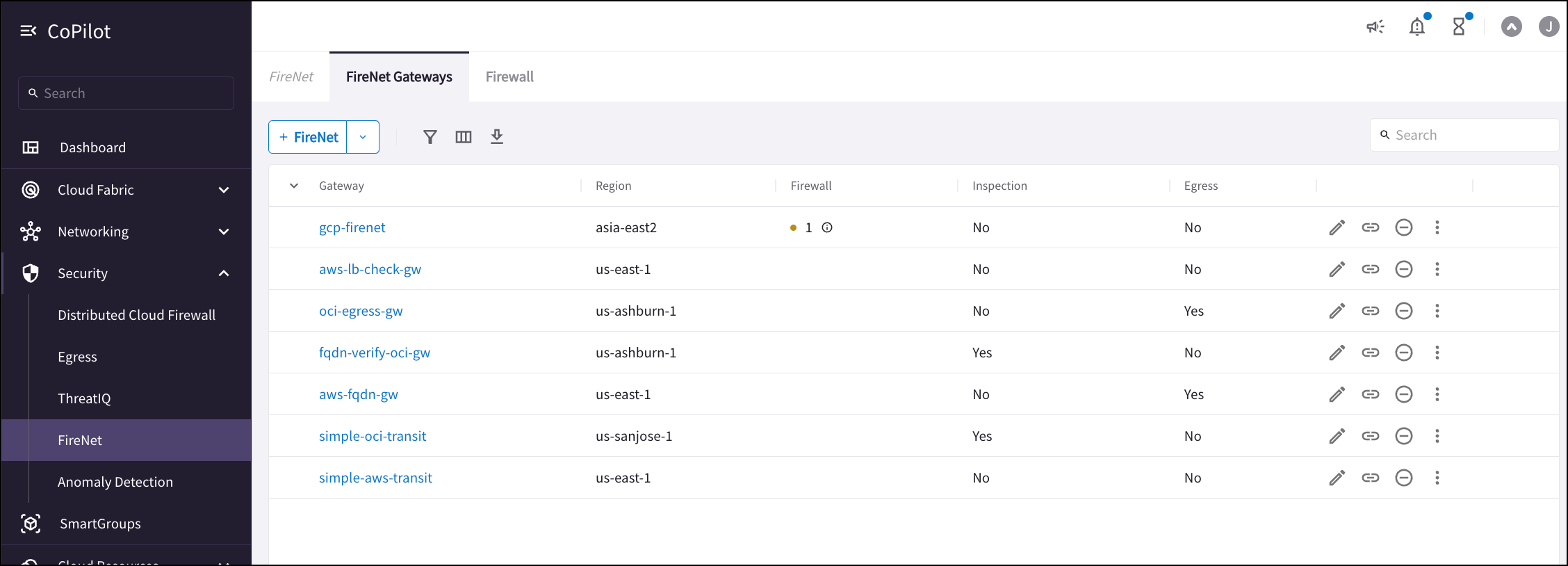FireNet Deployment Workflow
With Aviatrix FireNet you can insert firewalls into the Aviatrix Transit VPC/VNet for any supported cloud. FireNet provides simplified firewall instance deployment and scaling, and allows the firewall instances to inspect East-West (VPC/VNet to VPC/VNet) traffic, VPC/VNet to Internet (Egress) traffic, and North-South (VPC/VNet to on-prem) traffic.
Controller release 7.0.1577 or above is required to use FireNet in CoPilot. You can use FireNet in CoPilot to manage your existing FireNet environment (from Controller) or build a new FireNet environment.
|
Supported firewall vendors are Palo Alto VM-Series, Check Point CloudGuard, and Fortinet FortiGate. Panorama is also supported as a firewall manager for Palo Alto VM-Series. |

The Security > FireNet > FireNet Gateways tab shows the FireNets you have created, along with their attached firewalls, if any connection polices have been enabled (Inspection), and if Egress is enabled.
If you click the name of the FireNet, you can:
Prerequisites
-
If you want to attach Spokes to your FireNet, you must create the Spokes beforehand.
-
GCP: a minimum of four VPCs is required for the GCP FireNet solution with the Palo Alto VM-Series firewall. All VPCs should be in the same region.
-
Any FireNet connections that use BGP over LAN must also have DNAT or SNAT configured.
| If desired, you can create VPCs/VNets ahead of time that have the Transit + FireNet VPC Function option selected, ensuring that the necessary subnets and interfaces are already created in those VPC/VNets in preparation for using the Transit FireNet feature. If when adding FireNet to a Transit gateway you decide to use a VPC/VNet that does not have the Transit + FireNet function selected, you must subsequently create the necessary subnets and interfaces in the relevant cloud service provider. |
Workflow
-
Add one or more FireNets. You can create a standard FireNet (where traffic is inspected), an Egress FireNet, or an AWS TGW FireNet.
After you create a FireNet, you can select it on the FireNet tab and:
-
View any attached firewalls
-
View or modify connection policies
-
View its VPC/VNet route table
-
View or modify its settings
-
Primary and Secondary FireNet (AWS only)
In AWS (not AWS TGW) you can deploy a FireNet architecture that consists of one Primary and up to ten Secondary FireNet gateways. This allows you to scale to more than 125 HPE-enabled Spoke gateways and reduce the overall number of firewall deployments.
The Primary FireNet is the Transit Gateway where firewalls are attached. This FireNet can have its own Spoke Gateways and Site2Cloud or external connections.
Secondary FireNet Transit Gateways send traffic to the Primary FireNet to be inspected by the firewall. A Secondary FireNet can only attach to one Primary FireNet. Secondary FireNets can bypass Primary if the traffic does not require inspection. Traffic that does not require inspection is routed to the closest next hop.
Prerequisites for Primary and Secondary FireNet
-
Segmentation must be enabled on the gateways that will function as the Primary and Secondary FireNets before attachment occurs. You cannot enable segmentation after attachment.
-
SNAT/NAT cannot be configured for the FireNets in a Primary/Secondary FireNet configuration.
Prerequisites for Secondary FireNet
-
GWLB cannot be enabled
-
No firewalls attached
-
No egress static CIDR configured
-
No exclude CIDR configured
-
Local ASN configured
-
Network segmentation enabled